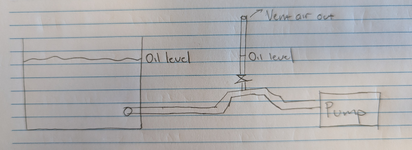Hi All,
I have recently installed a small bleed valve on our turbine jacking oil pump suction pipework to allow for the bleeding of built up air before operation, we have sloped the suction pipework to a high point and that is where the bleed valve is installed. This was due to previous air lock issues affecting our discharge pressure, currently our operators have to manually open this valve to bleed the air out but i was wondering if we install pipework as per the attached photo, whether we can leave it permanently open?
My thinking is that with the bleed valve open and the vent line raised to a high point above the oil level of the tank, the air can constantly vent out to atmosphere without the need for manual intervention. However i am having a hard time rationalising whether the oil that will be in the vent line will be sucked through the pump during operation, and then air ingress through the valve? Or will it always remain at the oil level of the tank even in operation? It's relatively simple but i cant seem to come up with a solid answer for what will happen?
Any guidance would be appreciated.
I have recently installed a small bleed valve on our turbine jacking oil pump suction pipework to allow for the bleeding of built up air before operation, we have sloped the suction pipework to a high point and that is where the bleed valve is installed. This was due to previous air lock issues affecting our discharge pressure, currently our operators have to manually open this valve to bleed the air out but i was wondering if we install pipework as per the attached photo, whether we can leave it permanently open?
My thinking is that with the bleed valve open and the vent line raised to a high point above the oil level of the tank, the air can constantly vent out to atmosphere without the need for manual intervention. However i am having a hard time rationalising whether the oil that will be in the vent line will be sucked through the pump during operation, and then air ingress through the valve? Or will it always remain at the oil level of the tank even in operation? It's relatively simple but i cant seem to come up with a solid answer for what will happen?
Any guidance would be appreciated.

